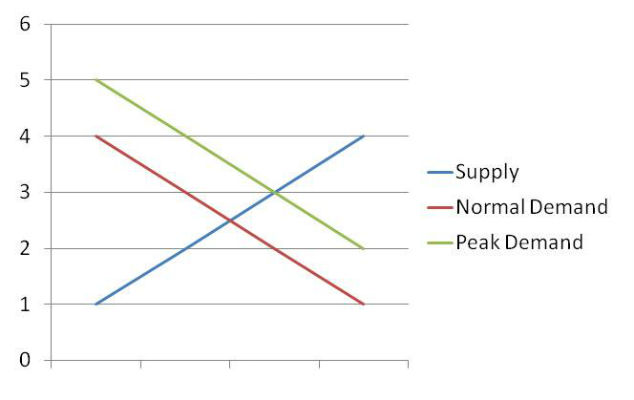Decoding Electricity Jargon: Peak Demand
Your electricity bill can be complicated, but understanding how it is formulated is an important step in taking control of your energy savings. We're here to help, by decoding some of the jargon you might find when learning about your energy. Today's topic: peak demand.
What is Peak Demand?
Electricity is a "live" resource. As large-scale power storage is still in development stages, most of our grids are set up so that electricity is bought, sold, and delivered in real time. This can be tricky to manage: power has to always be available when we need it, but when and how much electricity we use can vary widely depending on the time of day or the season. Grid operators and utilities must monitor demand constantly and make sure that it is constantly met with corresponding power supply.
Peak demand refers to the period (usually the half-hour or hour) in which consumer demand for electricity is highest. Peak demand records usually happen in the day during heatwaves, when everybody uses air condititioners and fans.
Peak demand goes by many names, including:
- Peak load
- Power demand
- On-peak
Why Does Peak Demand Matter?
While concepts like "peak demand" can often seem like the sort of thing that only concerns utility industry members and policy makers, peak demand can have considerable effects on the reliability of your power and your bill's bottom line. Let's take a look at how peak demand can affect you.
Power Supply
Balancing demand with supply on the electricity grid can be a delicate balancing act. In order to ensure that power will be available when needed, most states try to ensure that they can generate more power than they will actually need. This means that during times of "regular" demand levels, some power generation plants are inactive, but they can be fired up when needed.
However, sometimes demand for electricity will be greater than expected, such as during a heatwave when everybody wants to use air conditioners and electric fans. This can lead to power outages and brownouts if demand exceeds supply, which is another good reason why it's a good idea to be aware of how much energy you use in the summer. Check out our energy conservation methods for hot weather if there's a heatwave in your area and you hear your utility or grid operator talking about peak demand in the news.
Peak Demand and Renewable Energy
Peak demand also plays a part in discussions about renewable energy and its reliability. Our electricity systems are structured so that power supply must respond to changes in demand. But wind and solar don't work that way - wind is available according to local weather patterns, and there's not much we can do about changing how often we see the sun. Dealing with reliability issues and how to respond to times of peak demand is a current challenge in the debates about integrating more renewables into our grids.
For some, this might be a reason to favour coal and natural gas-fired power plants (which can be fired up or down in response to demand), at least until technological innovations overcome the reliability issue for renewables. But others argue that we should be looking into changing how and when we use electricity. Many utilities and grid operators are researching the possibilities of demand response to encourage a more stable and efficient demand for electricity. This may come in the form of Time of Use pricing (see below), or can get more technological with the help of smart meters and other smart devices.
Pricing
Put simply, peak demand means higher prices. Here's why:

Basically, when demand rises so does the price of electricity. Only the cheapest energy available is bought, sold, and delivered on the grid. When demand rises, additional generation plants must be fired up or purchased from neighbouring states at a higher cost. Consistently high demand (and correspondingly high prices for electricity) can raise the average monthly price for electricity if you are on a variable rate.
Time of Use Pricing
Some utilities and energy suppliers offer Time of Use pricing. With this pricing arrangement, the price you pay for your electricity depends on the time of day that you use it. "Peak" times are the times of day when most people tend to use electricity, such as in the morning before going to work, or in the evening when making dinner. The difference between peak and off-peak prices can vary by the provider, but is typically at least 4 cents/kWh difference, sometimes greater. If you have Time of Use pricing and are able to switch around 80 percent of your power usage to off-peak periods, you can make considerable savings.
Using Peak Energy to Save Money on Your Power Bills
Here are a few tips to use what you know about peak energy to cut your electricity bills:
- Changing When You Use Power
Even if you aren't on time of use pricing, it's not a bad idea to try to use more power during off-peak times. Though this may not seem to have much of an impact on an individual scale, if everyone in your area can change their habits they can help make demand more stable in your region. This can help avoid higher electricity prices in your area. - Energy Conservation
Another important way you can make a change is to try to improve your energy efficiency and save on how much energy you use. Looking for inspiration? We've got lots of tips on how to save energy at home, including how to save energy during peak demand times - Consider a fixed rate
The advantage of choosing a fixed rate for your electricity is that it will help shield you from dramatic monthly rate fluctuations, which you could get on a variable rate
Want More Information? Call us at 832-460-0233 to find out how you can find a great rate for your energy